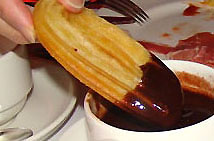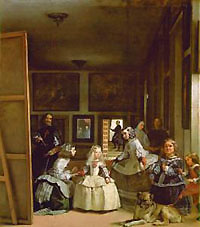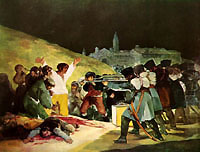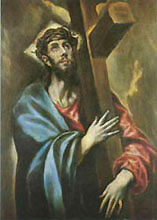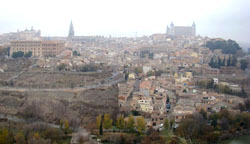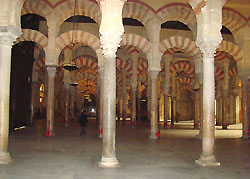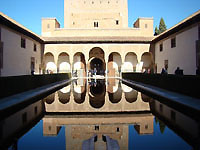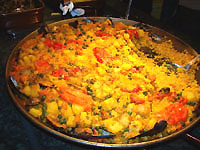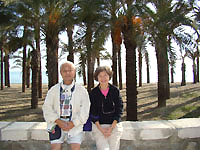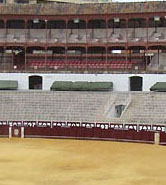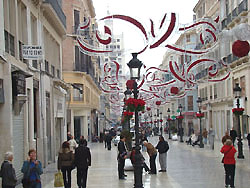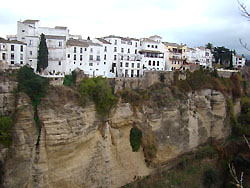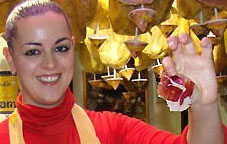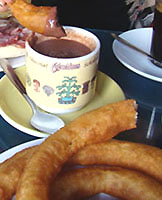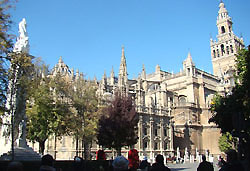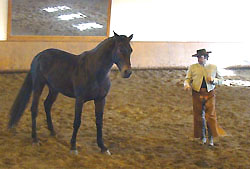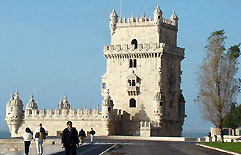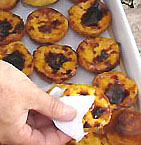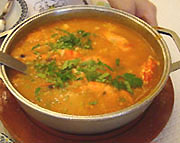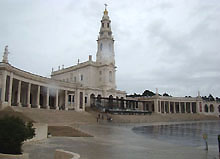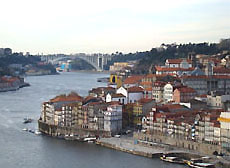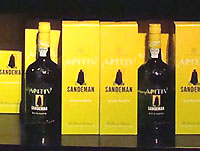|
Trip Summary:
On this 15-day trip we visited Madrid, Toledo, Cordoba, Granada, Torremolinos,
Malaga, Ronda and Sevilla in Spain. Then we crossed the border to Portugal to visit
Lisbon, Fatima and Porto. We spent two nights each in Madrid, Cordoba, Sevilla,
Lisbon and Porto; 3 nights in the Mediterranean resort town of Torremolinos.
To any friends planning a similar trip independently, we would suggest spending
one extra night each in Madrid, Sevilla, and Lisbon; omit Fatima and Porto. Too
many two-night stays are a bit hectic; a three-night stay will give you a day
free from packing or unpacking.
There were 32 members on this tour, almost all were seasoned travelers. GCT's
program director, Eduardo,
traveled with us the whole time. Our bus driver, Pedro, is from Portugal. He
drove a bus from Portugal to Madrid to start the tour with us; our tour ended in
Portugal, his home base. All the hotels used were four-star modern. All
breakfasts were included, as well as 4 lunches and 4 dinners.
There were two optional tours on this trip, a one-day excursion from Torremolinos to Tangiers in
Morocco, and an evening of Flamenco dinner show in Sevilla. We went to the
Flamenco dinner show but did not go to Tangiers. We knew that one-way
transportation from Torremolinos to Tangiers was a 2 hours' bus plus 45 minutes ferry. We imagined it would have been a long day,
so we decided to stay in Torremolinos to enjoy the sunny coast.
Food-wise, we loved churros (fried dough, similarly to
December sees Spanish clementines in season. The clementines we had throughout
Spain were very juicy and had more zing than the imported Spanish clementines we get at
home in the US.
As in the past, we researched and compiled our preparation documents for Spain
and Portugal before leaving home. Drop us an email if you'd like to have an
electronic copy of these documents.
Vincent brought an iPod Touch as well as a laptop on the trip. He had bookmarked
on iPod Touch the weather forecast of the six cities we'd spend nights in. Whenever
there was Wi-Fi, he'd get the iPod Touch's weather forecast updated. It was very
handy, because it helped us decide whether to dress in extra layers in the morning.
Transportation:
Guide Books:
Itinerary with links to picture pages:
Day 2 -
Arrival in Madrid photo Our neighbor, Paul, kindly drove us to Logan Express in Woburn yesterday afternoon. It snowed heavily in Boston in the morning but stopped before noon. We enjoyed our flight in a relatively new Airbus A340-600. Every passenger seat has its own individual entertainment LCD console with choices of 12 movies, so we started watching "Julie and Julia" before taking off. The aircraft also has a bank of 6 or 7 lavatories in the lower level, a few steps down toward the middle of the aircraft's belly, so that disruptions to passengers may be minimized. Madrid was raining lightly. A GCT rep picked us up in a van and drove to our downtown hotel, a gleaming four-star modern hotel on Atocha Street, not far from the Atocha RENFE train station. Our GCT tour director, Eduardo, was waiting for us. He gave us a package of info, suggested we to visit the Reina Sofia museum because it was open (while Prado was closed on Mondays) and is just across the street from our hotel. Then off we went, we were on our own until the welcome cocktail at 7 pm. (The welcome lunch was scheduled on the following day.) 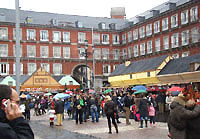 We walked about 20 minutes to Plaza Mayor (Mayor= major), a historical cobbled square
built in 1619, to see the Christmas market. Today was the 4th day of a 5-day
National holiday, so there were big crowds everywhere in Madrid, in restaurants, shops,
and top sights. Some of our tour
members went to tour the Royal Palace and had to wait in line for more than 3 hours.
While in the Plaza Mayor we
sought out the Casa Rua on the northwest corner of Plaza Mayor to try
their "Bocadillo de calamares" (fried squid in a bun). No sauce of any kind available, it was too dry to taste
good. We looked at other customers around us, all were seemingly enjoying the same fried squid
sandwich without sauce. Maybe our taste buds are not accustomed to sandwiches
like this? We walked about 20 minutes to Plaza Mayor (Mayor= major), a historical cobbled square
built in 1619, to see the Christmas market. Today was the 4th day of a 5-day
National holiday, so there were big crowds everywhere in Madrid, in restaurants, shops,
and top sights. Some of our tour
members went to tour the Royal Palace and had to wait in line for more than 3 hours.
While in the Plaza Mayor we
sought out the Casa Rua on the northwest corner of Plaza Mayor to try
their "Bocadillo de calamares" (fried squid in a bun). No sauce of any kind available, it was too dry to taste
good. We looked at other customers around us, all were seemingly enjoying the same fried squid
sandwich without sauce. Maybe our taste buds are not accustomed to sandwiches
like this?
Next, we walked to San Miguel Market, which was a delight in sight - bright, airy, clean, and bustling. From a fruit vendor we bought clementines. They were very juicy and tasty. Many bars in this market were doing a brisk business but there were also throngs of people jostling to buy food or find seat/table. Eventually, we were able to buy some tapas by pointing to what others before us were buying. 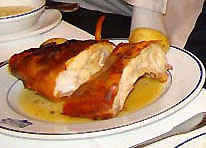 In the evening, the four of us went to
Restaurant Botin
for their roast suckling pig, recommended by our son Austin and daughter-in-law Elena. (Botin claims to
be the
oldest restaurant in the world, dating back to 1725.) Botin was
made famous by Ernest Hemingway, who wrote Botin's roast suckling pig into his novel
"The Sun Also Rises". We had read online reviews that said Botin is pricey
and touristy, but also worthy of a visit for its excellent food, so we
decided to give it a try, and also to celebrate sister Susan's birthday one day
ahead. We made reservation on Botin's website before leaving Boston. The
verdict? The roast suckling pig was good, the skin was very thin, like roast
chicken's skin, with very little fat. Vincent thought Botin's garlic soup really
stood out, very tasty and not garlicky at all. In the evening, the four of us went to
Restaurant Botin
for their roast suckling pig, recommended by our son Austin and daughter-in-law Elena. (Botin claims to
be the
oldest restaurant in the world, dating back to 1725.) Botin was
made famous by Ernest Hemingway, who wrote Botin's roast suckling pig into his novel
"The Sun Also Rises". We had read online reviews that said Botin is pricey
and touristy, but also worthy of a visit for its excellent food, so we
decided to give it a try, and also to celebrate sister Susan's birthday one day
ahead. We made reservation on Botin's website before leaving Boston. The
verdict? The roast suckling pig was good, the skin was very thin, like roast
chicken's skin, with very little fat. Vincent thought Botin's garlic soup really
stood out, very tasty and not garlicky at all.
Day 3 - Madrid photo (12/8/2009, Tuesday):
A local guide took us for a half-day panoramic tour of Madrid on bus. Madrid was cold, in the low 50F's. Madrid became Spain's capital in 1561 when Philip II moved his court from Toledo to Madrid. Yesterday, while driving from the airport to our hotel, we saw Madrid looked a lot like Taipei. But today, after driving to the new part of the city along the Castellana Avenue, we saw that Madrid is much grander, with many impressive buildings, squares, fountains and parks. Our welcome dinner was moved to a welcome lunch in a local restaurant. The food was good, plenty of RIOJA (pronounced as [RIO-ha], the name of a region where the grapes for the red wine were from) for those who like reds. We were free for the afternoon and evening. There were many sights to see but we only had time for one major attraction. The four of us chose to go to the Prado Museum instead of the Royal Palace. (By the way, Madrid's Royal Palace was commissioned by King Philip V. He was a grandson of Louis XIV of France and preferred speaking French in his court. Today's Spanish King, Juan Carlos I, is a descendent of this French Bourbon dynasty.)
Luckily, today was the last day of the 5-day National Holiday. Vacationers had already started leaving Madrid to go back home. Therefore, there was no line outside the Prado Museum when we went. Each of us rented an audio guide and followed a route highlighted in Rick Steve's Spain guide book to see master pieces by major artists such as Diego Velazquez [vel-LAHSS-kes], Francisco de Goya, and El Greco. So far, we have walked by several "Museum of Ham" stores, which is a franchise selling all kinds of ham as well as quick eats. But we did not know the differences from one kind of ham to the other until Day 9 in Ronda, when Eduardo told us about the best kind of ham. (Read Day 9 Ronda for details.) [Footnote: In the evening, the four of us went to Plaza Santa Ana area for tapas. On the way back to the hotel, a young man in his 20's (he was with two friends of similar age) called to Vincent's attention to tell him that he had dropped a gadget bag on the ground. (The Logitech gadget bag was in Vincent's coat pocket the last time he knew it.) After Vincent retrieved the gadget bag we continued walking, but the young man kept steps with us and hovered around Vincent. The young man first pulled out a cigarette and asked Vincent for a lighter. Vincent shook his head, no lighter. While we continued walking, the young man extended a hand, wanting to shake hands with Vincent. Vincent tried to avoid it, but the young man was persistent and displayed a broad smile, so Vincent extended his hand. As they shook hands, the young man playfully made a gesture as if he could wrestle Vincent to the ground. Mei-Ching yelled loudly to draw attention. The young man quickly pulled away, and also stopped following us. Afterwards, Vincent thought the young man must have picked the gadget bag from his coat pocket first, then after discovering that the bag had nothing in it, he threw it on the ground, called to Vincent's attention, and then tried to get close to him to get something else. Nothing was lost. This incident took place around 9:30pm, at the north-west corner of Plaza Santa Ana. We did not encounter any attempt like this for the remainder of the trip, and none of our tour members fell victim to pick pocketing the whole trip.] Day 4 - Toledo photo (12/9/2009, Wednesday):We left our Madrid hotel at 8am to go to Cordoba, but along the way we visited Toledo for half a day. This was how we could have visited so many places on this tour - when we transferred from A to B we visited C along the way.
Toledo is located about one hour south of Madrid. It was Spain’s capital until
1561, when Philip II moved his court to more-spacious Madrid. Toledo is well preserved,
and has a rich mix of Jewish, Moorish, and Christian heritage. It was once known as
the “City of Three Cultures” for its harmonious coexistence of Christian,
Muslim, and Jewish communities.
There are 80 churches in Toledo but only one cathedral. Toledo's cathedral is one of Europe's best. We had a very good local guide, Carlos, whose story-telling skill made the cathedral come alive for us. On the walls of a beautiful room (Sacristy?) in the cathedral where priests change clothes before and after services, there were 20 El Greco paintings as well as Goya, Titian, Rubens, and Velazquez, all privately owned by the cathedral. The cathedral has several doors. One of them is named King's Door, which opened only for kings and queens in the past. Since in this democratic era there are not many kings and queens, so now the King's Door also opens for heads of states and their spouses. The last time the Kings Door opened for an American was during the Clinton administration, when Hillary visited with daughter Chelsea and a friend of Chelsea's. We also went to the Church of Santo Tome (Church of St. Thomas), a simple chapel with El Greco's masterpiece, "The Burial of the Count of Orgaz." Orgaz is the name of a place, and the count at that time was also the mayor of Toledo. When El Greco was commissioned by the church to paint such a scene, he painted himself, his wife, and his son into the painting, so it was also a family portrait! El Greco spent two years completing this painting. Mei-Ching asked Carlos, the local guide, if El Greco was paid enough to live for two years. Carlos said that El Greco did not spend the whole two years on this painting alone, he also did some other work at the same time, in the name of waiting for inspiration. And yes, El Greco was paid well by the church for this painting. After lunch, we got on our bus to continue a 5-hour ride to Cordoba. In Spain and Portugal there are very strict regulations governing how often a bus driver must take a break of 30 minutes after a certain length of driving. (There is a CD-like black box on every European bus to record the bus' movements at all times.) So we made stops along the way, about 15 minutes if just for us to wash hands, 30 minutes when Pedro must take his mandatory 30 minutes break. On both sides of the highway, we saw olive trees after olive trees, perhaps more than what we saw in Greece. Spain is the number one olive oil producing country in the world right now. During the long bus ride, Eduardo talked to us about Spain's past and present, as well as Q and A. When he said Spain also produces almond, Mei-Ching asked him how to order Almond gelato in Spanish. Turrón helado, he said. (The leading "h" in helado is not pronounced.) We ordered Turrón helado a few days later in Costa del Sol, but it was not in the same league as the Mandorla ([MON-dor-la] = almond in Italian) gelato we had in Sicily this past May. To us, the Sicilian almond gelato is more flavorful. We arrived at Cordoba in the evening, checked into Hotel Cordoba Center, had an
included buffet dinner at the hotel's restaurant. Day 5 - Córdoba photo (12/10/2009, Thursday):
Islamic Córdoba (for 500 years from 758 - 1236 AD) was Medieval Europe's Culture Capital, Córdoba's Mezquita (The Great Mosque) is Europe's best Islamic site after Granada's Alhambra. A local guide took us on a walk through the old Jewish quarter (La Juderia). Then he guided us to tour the Mezquita, a beautiful Mosque with a Christian Cathedral built in the middle of it. Within the mosque compound there is the Patio de los Naranjos (the "patio of the orange trees") bearing a lot of orange fruit. For lunch on our own, the four of us went to El Caballo Rojo ("The Red Horse") located across from the Mezquita on the northern side. Its upstairs is a pricy restaurant that saw many illustrious guests, including the Crown Prince of Japan, but we followed guidebook tips to eat tapas in the ground floor bar for a lighter meal. The tapas were good, the price reasonable. We did not order the famous Córdoba dish, Ox tail (rabo de toro), because Eduardo advised us to save Ox tail for dinner (our lunch break was brief too). After lunch, Eduardo led the entire group for a walk from the Mezquita in the old town to Plaza Tendillas in the new town, about half way back to our hotel. We walked through many narrow alleys and saw several beautiful houses, neat courtyards and squares. We also saw a Roman ruin with several columns still standing. The walk was easy and relaxing with a few pleasant surprises along the way. Eduardo made the walk very enjoyable. When we paused in front of many orange trees bearing oranges, Eduardo told us these oranges are called Sevilla oranges. They are bitter and not edible (that explains why there were still so many fruit on the orange trees, no one plucked them.) Eduardo said these Sevilla oranges are exported to UK to make marmalade, to France to make into a liqueur, and its flowers are exported to France as a key ingredient in the famous Chanel No 19 perfume. For dinner, we went to a restaurant in the new town called Taverna Salinas, listed in every guide book we read. We even ordered the eggplant with honey, as well as potato with garlic, specifically recommended by one of the guide books. (In addition to those two dishes we also ordered two meat dishes.) However, none of the dishes we ordered stood out, and the restaurant was freezing and deserted on a winter evening at 8:00pm. Perhaps the restaurant would be a lot more cheerful during the daytime when there was sunlight streaming down from the sky? Or perhaps we did not order the dishes that made the restaurant popular? Or perhaps the guide book authors just copied from each other without checking it out themselves? After a so-so dinner, we walked to the old town to see the Roman bridge just south of the Mezquita. We found the old town pretty much deserted on this winter night. The locals all went back to their home or to the new town. Luckily, there were four of us walking together, otherwise we might have turned back before reaching the Roman bridge. After seeing the illuminated Roman bridge and the Mezquita in the night, we took a taxi back to the hotel. Day 6 - Alhambra in Granada (12/11/2009, Friday):
Alhambra is a UNESCO site. It is a Moorish citadel that encompasses a castle, several palaces, and manicured gardens. In Arabic, Alhambra means "the red one" and refers to the reddish appearance.
When we arrived at Alhambra, two local guides were waiting for us. Our group of 32
were divided into two smaller teams each to follow a guide. The entrance to
the Nazaries palace is assigned with a specific time slot. Our reserved time slot was 12
noon. We spent an hour before noon walking around the premises, visiting the Generalife gardens (pronounced as hen-ne-ra-LEE-fe,
not General-life. ^_^). At 12 noon we entered the Nazaries Palace. Suffice to
say we were wowed. The crown jewel of the palace is the area surrounding the Court of Myrtles with
a long reflection pool.
We did not have time to visit the Cathedral in Granada. After Alhambra, we walked directly to a hotel called Alixsedra for an included fabulous lunch buffet. There was hake fish, meat, bean soup (with potato, chickpea, chicken, and salted ham) and a fabulous paella. Additionally, there was a cold salad station, and a desserts and fruits station. By the way, here is a very good interactive virtual walking tour of Alhambra from an online magazine website. After lunch, while waiting for our bus to pick us up, we chatted with Eduardo and asked him about the name of Granada and the famous song "Granada". He said that Granada in Spanish means pomegranate, the fruit. A military grenade is also called granada in Spanish, because when you smash a pomegranate the seeds will splatter in every direction. As for the song Granada, it is a Mexican song written by a Mexican composer named Agustin Lara who dreamed of coming to Granada but never made the trip. Here is a YouTube video of José Carreras singing Granada with lyrics and English subtitle. This video clip was taken from the first Three Tenors concert, performed in 1990 at the Terme di Caracalla in Rome, Italy. Our bus arrived at Torremolinos in the Costa del Sol shortly after 4 pm. After checking into our beach-front hotel, Melia Costa del Sol, Eduardo took us for a walk around the neighborhood. This is Eduardo's territory, he lives in Torremolinos. The four of us went for a hearty tapas dinner at Casa Lopez, one of the restaurants in Torremolinos recommended by Eduardo. In all, we had a perfect day today - we saw an A+ sight, had an A+ lunch buffet, checked into a hotel room with a view to the Mediterranean sea, and had a very hearty tapas dinner. Day 7 - Torremolinos (Costa del Sol) Photo (12/12/2009, Saturday):
Having decided not to take the optional tour to Tangiers, we slept in and went to the hotel restaurant for breakfast around 9:30am. A dozen or so of our tour members not going to Morocco also sauntered in, taking it easy today. We forgot to take photos of the hotel's breakfast today to capture images of the exotic fruits, including soft persimmon and a fruit that is very similar to Taiwan's Si-Gia (旺來釋迦) The weather was warm, sunny, and very pleasant. Mei-Ching wore sandals and Vincent wore shorts. We walked along the seaside promenade to the fishermen's quarter called La Carihuela. There were many shops and restaurants. We went to a seaside restaurant called La Lonja (meaning "The Market", recommended by our hotel clerk) for a seafood lunch. This is a very large restaurant with many celebrity photos mounted on the wall. The various fried seafood plates we ordered were all very good, the prices were 40% higher than last night's at Casa Lopez, but that is what you pay for eating at an upscale establishment on the beach front. In the evening, we went to a restaurant near the hotel (and recommended by Eduardo) for a seafood paella. Suffice to say that this paella was below our expectations; the paella we had yesterday at the lunch buffet in Alhambra was far better. Susan commented that the best paella she ever had was in Nice when we went to Switzerland and southern France together in 2001. It was a great relaxing day by opting out of a day-trip to Africa. Day 8 - Málaga Photo (12/13/2009, Sunday):
We first stopped at Málaga's Bull Ring. There is a small museum in the bull ring honoring the great matador, the late Antonio Ordóñez. This Antonio Ordóñez was a long-time friend of both Ernest Hemingway and movie star Olsen Welles. Hemingway wrote a book titled The Dangerous Summer of 1959 as an account of Ordonez's rivalry with the matador Luis Miguel Dominguin (also Ordonez's brother-in-law). Antonio Ordóñez's two grandsons, Francisco Rivera Ordóñez and Cayetano Rivera Ordóñez, are also bull-fighting in Spain. Being young and dashing and from a legendary bullfighter family, they were featured in a segment of CBS' 60 Minutes titled "The Blood Brothers" a few years ago. Then we stepped onto the arena where Eduardo explained the bull-fighting rules while a young apprentice named Sergio demonstrated the matador moves to us. This was a GCT exclusive, and it was quite an eye-opener to learn about all these bull-fighting traditions and rules in depth. Fortunately, we were not scheduled to witness a bloody bullfight, because we did not think we could sit through it.
While walking in Málaga, Eduardo pointed out a 3-story yellow house where Pablo Picasso grew up as a child. We also stopped outside the Pablo Picasso museum, which was established after Pablo Picasso's daughter-in-law, Christine, donated 250+ pieces of Picasso's paintings and hand picked a building as a museum to house and exhibit these paintings. In a very diplomatic way, Eduardo said that it was not known whether these 250+ pieces were paintings the artist was unable sell, or if he meant to keep them within the family to begin with. After the city tour, we took a one-hour bus ride heading north to a small village called Salinas for a home-hosted lunch. It is a long story why Salinas was selected to host GCT's home-hosted lunch, but here we were, in a small rural village. We were randomly divided into small groups of 6 or 7 people to go to different families' homes. Our small group of 6 included the Tzengs, the Lius, and the Parsons from California. None of us spoke Spanish, while our hostess could not speak English. Her husband greeted us then disappeared, so he probably did not speak English, and there was no one else at the house. So, we ate what the hostess prepared for us (wine, salad, chicken/vegetable soup, a main course of pork, coffee and packaged cookies). We talked entirely among ourselves. When it was time to leave, Eduardo came to collect us. We then briefly toured their neat house and courtyard before saying thank you and good by, and the hostess said adios to us. Judging from the lack of meaningful interaction with the hostess, we thought the time (meal time plus the bus time to and back from Salinas) could have been better spent if we were let loose in downtown Málaga for the afternoon. However, a few of the small groups happened to have member(s) speaking Spanish and we heard they had a good time over a home-hosted lunch. Day 9 - Ronda Photo (12/14/2009, Monday):
Ronda is located on a plateau 4000 ft above sea level. It has a natural gorge, river, and cliff to protect it against invaders. That is why Ronda has been established as a town since Roman times. Before entering the town, Eduardo pointed out a pretty house on the outskirts and said that it was the estate of the great matador, Antonio Ordóñez. (Remember we saw his statue and museum in Malaga's bullring? There are two legendary bullfighter families from Ronda, one is the Ordóñez and the other is the Romero.) Hollywood movie star Olsen Welles and Antonio Ordóñez were great friends. After Olsen Welles passed away, his daughter scattered his ashes on this estate of Antonio Ordóñez's. Ernest Hemingway also visited Ronda often. Can't remember who made the quote "Find me in Ronda" stick.
We were given one hour of free time for lunch on our own in the town center. We walked a bit and found a cozy shop full of locals. We sat upstairs and ordered coffee, tea, sandwiches and churros. The churros were hot off the frying pan, and looked much more like Taiwanese 油條 than those served at the hotel's breakfast. These churros dipped into hot chocolate warmed our hearts, especially on a cold day like this. The tasty churros enhanced our fond memories of Ronda. We arrived in Sevilla in mid afternoon and had a bonus introductory tour of the Plaza Espana. Eduardo had Pedro drop us off at the Spanish Pavilion in the Plaza Espana that was built for the 1929 Latin-American Fair. In front of the Spanish Pavilion we saw a wedding party taking photos. We learned that they were from Wenzhow ZheJiang, China. Imagine flying from China to Sevilla for a location wedding and bringing 3 film crews plus two dozen friends and families with you? Wow! Day 10 - Sevilla photo (12/15/2009, Tuesday):
The Moors ruled Sevilla for 500 years until 1248. On 8/3/1492, Christopher Columbus (1451-1506) set sail from Palos (near Huelva, 60 miles west of Sevilla) with three ships and 90 men, hoping to land in Asia. In the 17th century, Sevilla was Spain’s largest and richest city with trading ships cruising up the river to the dock at the city. Sevilla’s golden age ended when the harbor silted up and the Spanish empire crumbled. In the morning, we had a panoramic bus tour of the city, then a walking tour of the Barrio Santa Cruz (the Jewish quarter) and the Cathedral with a local guide. The Jewish quarter in Sevilla looked very similar to the Jewish quarter in Toledo and Córdoba. As for the Cathedral, some guidebooks say Sevilla's Cathedral is the 3rd largest in Europe, just behind St. Peter's in the Vatican and St. Paul's in London. But when we were in St. Isaac Cathedral (in St. Petersburg, USSR) in 2004, our Russian guide told us St. Isaac Cathedral was the 3rd largest cathedral in the world, just behind St. Peter's and St. Paul's. So which is the 3rd largest cathedral in the world? (or in Europe?) Without prompting, our Sevilla local guide said to us, "Which is the largest cathedral in the world? Depending on if you are ranking by the height of the dome or by the diameter of the dome, or by the square footage." Then he pointed to a Guinness Book certificate displayed in a glass case in the cathedral which certifies Sevilla's Cathedral as the world's largest cathedral when measured by square footage! 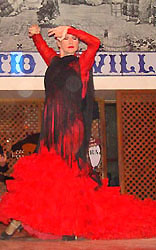 After
the Cathedral, it was free time. The four of us had a very expensive tapas lunch
at a restaurant near the Cathedral - we walked into Cerveceria Giraldillo by
mistake, when we were actually looking for Cerveceria Giralda, which is situated
next door rounding the corner on Mateos Gago 1. We did not realize our mix-up until in the evening when
we saw our program director Eduardo. I mentioned to him that we had a very
expensive tapas lunch, the prices were high and the portions tiny. He told me that I had asked him about a restaurant named Cerveceria Giralda
just before the team broke up for lunch, but he later saw the four of us eating
lunch at Cerveceria Giraldillo. Well, my mistake for not checking the
name spelling carefully. After
the Cathedral, it was free time. The four of us had a very expensive tapas lunch
at a restaurant near the Cathedral - we walked into Cerveceria Giraldillo by
mistake, when we were actually looking for Cerveceria Giralda, which is situated
next door rounding the corner on Mateos Gago 1. We did not realize our mix-up until in the evening when
we saw our program director Eduardo. I mentioned to him that we had a very
expensive tapas lunch, the prices were high and the portions tiny. He told me that I had asked him about a restaurant named Cerveceria Giralda
just before the team broke up for lunch, but he later saw the four of us eating
lunch at Cerveceria Giraldillo. Well, my mistake for not checking the
name spelling carefully.After lunch we toured Sevilla's Alcázar (castle) on our own. The Alcázar is still used as a royal residence, so it may be closed to visitors when the King or Queen were in town. Admission is free for anyone over 65, including non-EU citizens, so we went. We have read from guide books that the Alcázar was modeled after the Alhambra, and pretty soon we could see that too. Since we had been to Alhambra a few days ago, we decided not to waste time there. We exited the Alcázar and walked to the new town for sight-seeing. We passed a Starbucks, went in to buy coffee mugs with the Spain and Sevilla logo for Ayumi. She collects Starbucks mugs from all around the world. In the evening, we joined a GCT's optional Flamenco show at a night club called "El Patio Sevillano" near the bull ring (where the Carmen story is based). There are at least four reputable Flamenco clubs in town but this one gave GCT members special treatment, and we think that's why GCT tours chose to go to this club. The show was entertaining, the after-show dinner was good. The special 30-minute introductory session (for GCT members only) on Flamenco dance before the show was educational and enlightening. The highlight of the evening, however, was Eduardo’s impromptu dance on the stage with four of the female flamenco dancers. Vincent captured Eduardo’s guest performance of "dancing with the stars" in a video posted on YouTube: http://www.youtube.com/watch?v=VFYo-bElMaw. Eduardo told us afterwards that he has been Flamenco-dancing since a young boy. His friends can either play guitar or can sing. Therefore, on festive occasions they would get together to play guitar, sing songs, and dance to celebrate. Day 11 - Horse Farm visit (12/16/2009, Wednesday):
While our bus made a stop for 30 minutes because Pedro had to take his mandatory 30-min break, we had plenty of time to browse the highway gas shop. We immediately noticed that a cup of coffee was only 0.98Euro, almost half the price of what we paid in Spain. We also met a Japanese couple from Tokyo who was on a house-exchange with a friend in Portugal for two months. The one-thousand acre "Brito Paes" Ranch has been in existence for around 200 years, and has always been dedicated to breeding and development of horses. For the past 25 years, it has concentrated on breading sports horses and bullfighting horses. At the time we visited, the ranch had 15 Lusitanian mares and 5 studs for reproduction. Most of their horses were sold to foreign countries. A member asked about prices. The lady owner, Maria Brito Paes, said they roughly range from 15,000 to 50,000 Euros per horse. We had a fabulous lunch in a converted barn with hearty vegetable soup and stewed Portuguese chicken. We then moved to another barn to see a horse show with Maria's older son riding the horses. Maria's husband passed away 12 years ago. At that time, her six children were ranging in age from 2 to 20. Today, she and her older sons run the ranch. Breeding horses is a tough business for women to be in, but she looks strong and wise and capable. We were appreciative of the hospitality she showed to GCT travelers, and wished her much success in her business. Our hotel in Lisbon, Hotel Tryp Oriente, is located on the eastern edge of the city, next to the Oriente train station, and across from a modern shopping mall named after Vasco da Gama. This whole area was developed for the 1998 World's Fair, so there are many new buildings in this area. In the Vasco da Gama mall there is a well-managed food court on the 2nd floor with many choices of varieties. One vendor there sells very tasty Argentine grill specialties. We had grilled calamari and grilled pork, which were really delicious. Others who had grilled steak or grilled chicken all said they were very good. Wish we could find an Argentine specialty restaurant near Boston! Upon first checking into our Lisbon hotel, we heard the hotel staff saying "Obrigato", sounded like they were speaking Japanese! A few minutes later, we learned that "Obrigato" is the Portuguese "Thank you", which sounded very close to "Arigado" (Japanese "Thank you"). Judging from the historical trading relationships between Japan and Portugal as well as Portugal's influence on the westernization of ancient Japan, it is plausible that Japanese tempura originated from Portuguese bakarau. We wouldn't be surprised if the Japanese "Arigado" was transformed from "Obrigato". We also learned that the popular Nagasaki (sponge) cake was introduced to Japan by Portuguese missionaries during the mid 16th century. Day 12 - Lisbon (12/17/2009, Thursday):
Belém is located 6km to the west of Lisbon city center. Belém is famous as the place from which many of the great Portuguese explorers set off on their voyages of discovery. In particular, it is the place from which Vasco da Gama departed for India in 1497. After Vasco da Gama opened the sea route to India and established a Portuguese trading route to the Indian Ocean, Italian dominance of trading spices with Asia declined and the Portuguese global power rose. Portugal was a great superpower nation for 200 years, from roughly 1500 to 1699 (16th-17th century). Brazil was Portugal's largest colony (and the first to become independent). A lot of gold and wealth was brought back from Brazil during that time. Belém is where many of Lisbon's top sights are - the Belém Tower, the Monument to the Discovers, and the 16th-century Monastery of Jerónimos, built on the site of a humble sailors' chapel where they spent their last night in prayer before embarking on their frightening voyages.
The Wikipedia page says this Portuguese-style egg custard has become available in bakeries in Macau, Hong Kong, Singapore, Malaysia and Taiwan, to name a few places. If that is the case, then the egg custard we bought in Boston's Chinatown bakery must be an alteration of this Portuguese egg custard. Therefore, we have been eating egg custards originating from Portugal without knowing it. Our young and pretty local guide speaks excellent English. We asked her where she learned her English. She said from movies. We asked if she had a favorite movie. Yes, The Sound of Music, she said. Since Portugal was neutral during World War II, there were many foreign spies operating in Lisbon. We asked the local guide where the spies converged during WWII. She said it was in a seaside resort north of Lisbon.
After lunch, we walked to Alfama, an old medieval Moorish district. Then we took
a cab back to our hotel and strolled along the pleasant waterfront
area developed for the 1998 World's Fair. In the evening, we had a delicious
Argentine grilled specialty for dinner. See today's photo for details. Day 13 - Fatima (12/18/2009, Friday):
Along the way, we stopped at Fatima to visit the site where, on 5/13/1917, three children were tending sheep when the sky lit up and a woman – Mary, the mother of Christ – appeared standing in an oak tree. In the midst of bloody WWI, she brought the message that peace was coming. The war raged on, so on the 13th day of each of the next five months, Mary dropped in again to call for peace and to repeat three messages. Word spread, bringing many curious pilgrims. The three kids – Lucia, Francisco, and Jacinta – were grilled by the authorities but the children remained convinced of what they’d seen. In 1930, the Vatican recognized the Virgin of Fatima as legit. Fatima, Lourdes (in France) and Medugorje (in Bosnia) are the three big Mary sights in Europe. For the four of us, Fatima was just a curiosity. Actually, we did not mind if this stop were omitted. In the afternoon, we checked into our Porto hotel, Hotel Vila Gale Porto. There was still daylight so Eduardo took us for a walk to downtown St. Catarine area for a look and see. We went to an establishment called Majestic Cafe for coffee and pastry. The decor of this elegant cafe was 1930's. There were a pianist and a trombonist playing lively music. The St. Catarine Mall on the same street had a food court, but did not have a vendor selling Argentine grilled food, which was a disappointment for Mei-Ching. She was hoping to have another Argentine grill for dinner. Day 14 - Porto (12/19/2009, Saturday):
We had a half day tour of the city of Porto with a local guide, then went to a winery called Sandeman for a wine tour. Port is a fortified wine. Brandy is added to the partially fermented grape juice during production to halt the fermentation. Brandy makes the wine stronger, and the left over sugar from incomplete fermentation makes the wine very sweet. That distinguishes the strength, the sweetness and the smoothness of all port wines. The sophisticated flavors come from the soil and climate where the grapes are grown, in the Douro Valley region.
After walking in the downtown area for more sightseeing, we took a metro back to the hotel. The metro was efficient, slick and sparkling clean. We had a farewell dinner at a local restaurant. The food was good, the spirit merry. We said good-bye to everyone for sharing an incredible trip touring Spain and Portugal together. Day 15 - Fly home to Boston (12/20/2009, Sunday): Last night after a farewell dinner, we heard about heavy snow falling in parts of the USA (some airports were closed) and also snow storms hitting northern Europe, so we were a little bit concerned, hoping our flights would not be delayed. Luckily, our flight from Porto left on time, and our connecting flight from Frankfurt to Boston left 30 minutes late but caught up en-route, so we arrived at Logan at 2:45pm, only five minutes behind schedule. The streets outside Logan's Terminal E were snow and slush, our cab driver told us that it had been snowing since midnight, and the snow had just stopped two hours ago. However, he drove us home without any difficulty. We enjoyed the Spain and Portugal trip very much. We found both Spain and Portugal to be full of histories, yet very modern, clean, and traveler-friendly. During those 15 days, it seemed that every day there was new history to absorb and new sights to behold. GCT's program director Eduardo and our driver Pedro did a fantastic job; all the local guides contracted by GCT were all very good. We would recommend this trip to friends who are interested in visiting Spain (and/or Portugal).
|
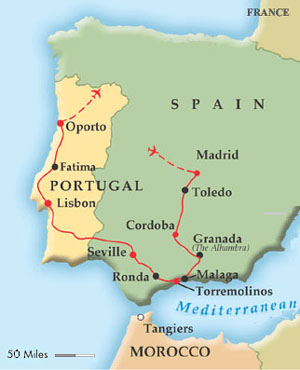 We
were just discussing with sister Susan and Brother-in-law Ken about visiting
Spain as our next vacation destination when we saw a great last-minute
special deal offered by Grand Circle for traveling from 12/6 to 12/20. GCT
was the company we went to Sicily with this past May. We had been very happy with
past trips with GCT/OAT, so we were ready to go.
We
were just discussing with sister Susan and Brother-in-law Ken about visiting
Spain as our next vacation destination when we saw a great last-minute
special deal offered by Grand Circle for traveling from 12/6 to 12/20. GCT
was the company we went to Sicily with this past May. We had been very happy with
past trips with GCT/OAT, so we were ready to go.
